Graph theory glossary Yulia Burkatovskaya Department of Computer

Graph theory glossary Yulia Burkatovskaya Department of Computer Engineering Associate professor 1

Topics l l l 2 Basics Connectivity Paths

1. Basics l l l 3 Graphs and related objects Adjacency and incidence Isomorphism Types of graphs Subgraphs

1. 1. Graphs and related objects Graphs are mathematical structures used to model pairwise relations between objects. 4

Undirected graph (simple graph) A simple graph G(V, E) is a pair of sets: l V – the set of “vertices" or "nodes“; l E – the set of “edges” or “arcs” that connect pairs of nodes. An edge (an undirected edge) is an unordered pair of different vertices. An edge e=(a, b) joins vertices a and b. The vertices a and b are the end vertices or the ends of the edge e. 5

Undirected graph (simple graph) Example G(V, E) V={a, b, c, d, e, f} E={(a, b), (a, d), (b, e), (b, c), (b, f), (c, f), (e, f)} l l 6 It is possible to write ab instead of (a, b); ab=ba.

Directed graph (digraph) If edges are ordered pairs of different nodes, then edges are called directed edges and a graph is called directed graph or digraph. For an edge e=(a, b) the vertex a is its head and the vertex b is its tail. Example 7

Mixed graph If both undirected and directed edges are allowed, then a graph is called mixed graph. Example 8

Multigraph Edges with the same ends (or with the same head and tail) are multiple edges. If multiple edges are allowed, then a graph is called multigraph. Example 9

Pseudograph A loop is an edge whose endpoints are the same vertex (e=vv). If loops are allowed, then a graph is called pseudograph. Example 10

Combinations 11

Graph invariants A graph invariant is a property of graphs that depends only on the abstract structure, not on graph representations such as particular labellings or drawings of the graph. The number of vertices of a graph is its order (notation p=|V|). The number of edges of a graph is its size (notation q=|E|). Example p=6 q=7 12

1. 2. Adjacency and incidence Consider an edge e=ab of a graph (directed or undirected). The vertices a and b are incident with the edge e. The edge e is incident with the vertices a and b. The vertices a and b are adjacent. Edges incident with the same vertex are adjacent. 13

Adjacency and incidence Examples 14 The vertices a and b are adjacent. The vertices a and e are not adjacent. The edges ab and ad are not adjacent. The edges be and ad are not adjacent. The vertex a and the edge ab are incident. The vertex c and the edge ab are not incident.

Neighbours Consider an undirected graph G(V, E) and a vertex a V. The set N(a)={b: ab E} is the set of neighbors of the vertex a. Example 15

Neighbours Consider a directed graph G(V, E) and a vertex a V. The set N+(a)={b: ab E} is the set of out-neighbors of the vertex a. The set N–(a)={b: ba E} is the set of in-neighbors of the vertex a. Example 16

The degree of a vertex For an undirected graph the degree of a vertex v (notation d(v)) is the number of edges incident with v. Examples 17

The degree of a vertex A loop vv adds 2 to the degree of a vertex v. Example 18

The degree of a vertex For a directed graph there are three characteristics: ● the out-degree of a vertex v (notation d+(v)) is the number of edges with the tail in v: d+(v)=|{vu: u V, vu E}|; ● the in-degree of a vertex v (notation d–(v)) is the number of edges with the head in v: d-(v)=|{uv: u V, uv E}|; ● the degree of a vertex v (notation d(v)) is the sum of the outdegree and the in-degree of v: d(v)= d+(v)+d-(v). 19

The degree of a vertex Examples 20

The degree of a vertex Examples 21

Graph invariants Minimum degree Maximum degree 22 Example δ(G)=1 Δ(G)=4

Particular cases l l l 23 A vertex with degree 0 is called an isolated vertex. A vertex with degree 1 is called a leaf vertex or end vertex. This terminology is common in the study of trees in graph theory. A vertex with degree n − 1 in a graph on n vertices is called a dominating vertex.

Handshaking lemma (Leonhard Euler) Lemma 1. The doubled number of edges of a finite undirected graph is equal to the sum of the degrees of vertices: Lemma 2. Every finite undirected graph has an even number of vertices with odd degree. 24

1. 3. Isomorphism Graphs G(V, E) and G’(V’, E’) are isomorphic if there exists a bijection φ: V→V’ such as for all x, y V: xy E if and only if φ(x)φ(y) E’. Isomorphic graphs are not distinguished. To prove that graphs are isomorphic it is necessary to find a bijection φ. To prove that graphs are not isomorphic it is sufficient to prove that one graph has a certain property and another graph has not the property. 25

Example: isomorphic graphs 26

Example: nonisomorphic graphs All the vertices 1, 3 and 5 (and 2, 4 and 6 ) of the graph on the left are pairwise adjacent. There are no such three vertices in the graph on the right. 27

1. 4. Types of graphs A graph is complete if all its vertices are pairwise adjacent. A complete graph with p vertices is denoted as Kp. The number of the edges of Kp is equal to p(p– 1)/2. 28

Types of graphs A graph is empty if any pair of its vertices are not adjacent (E=Ø). A graph is k-regular (regular) if all its vertices have the same degree k. 29

Types of graphs A graph is two-partite (bipartite, bigraph) if the set of its vertices can be divide into two subsets V 1 and V 2 so that every edge connect vertices from different subsets, i. e. V= V 1 UV 2, V 1∩V 2 =Ø, for all xy E: x V 1, y V 2. 30

Types of graphs A graph is complete two-partite (bipartite, bigraph) if every vertex from V 1 is adjacent with every vertex from V 2, i. e. V= V 1 UV 2, V 1∩V 2 =Ø, for all x V 1, y V 2. : xy E. A complete bigraph where |V 1|=n, |V 2|=m is denoted as Knm. 31

Types of graphs A graph is trivial if |V|=1, |E|=0. 32

1. 5. Subgraphs Consider two graphs: G(V, E) and G’(V’, E’). If V’ V and E’ E then G’ is a subgraph of G (less formally, G contains G, notation G’ G). Example. 33

Subgraphs If G’ G and E’ contains all the edges xy E: x, y V’, then G’ is an induced subgraph of G. We say that V’ induces G’ in G and write G’=G[V’]. Example. 34

Subgraphs If V’=V then G’ is a spanning subgraph of G. Example. 35

Subgraphs If V’≠V and E’≠E then G’ is a proper subgraph of G. 36

2. Connectivity l l 37 Walks Distances Connectivity of simple graphs Connectivity of directed graphs

2. 1. Walks A walk is a sequence of vertices and edges <v 0, vn>=v 0 e 1 v 1…vi– 1 eivi…vn– 1 envn, where ei=vi– 1 vi. A walk is closed if its first and last vertices are the same, and open if they are different. If there are no multiple edges then it is possible to omit edges Examples. 38

Trail and tour A trail is an open walk in which all the edges are different. A tour (or a circuit) is a closed walk in which all the edges are different. Examples. 39

Path and cycle A path (or a chain) is an open walk in which all the vertices (and hence the edges) are different. A cycle (or a circuit) is a closed walk in which all the vertices are distinct. Examples. 40

2. 2. Distances The length of a walk is the number of edges that it uses. The shortest path <u, v> is a path of minimal length | <u, v> |. The distance between two vertices d(u, v) is the length of a shortest path <u, v>, if one exists, and otherwise the distance is infinity. Examples. 41

Distances The eccentricity ε(v) of a vertex v is the maximum distance from v to any other vertex. The diameter D(G) of a graph G is the maximum distance between two vertices in a graph or the maximum eccentricity over all vertices in a graph. The radius R(G) is the minimum eccentricity over all vertices in a graph. . 42

Distances Vertices with maximum eccentricity are called peripheral vertices. Vertices of minimum eccentricity form the center. Examples. 43

2. 3. Connectivity of simple graphs If it is possible to establish a path <u, v> from vertex u to other vertex v, the vertices u and v are connected. If all the pairs of vertices are connected, the graph is said to be connected; otherwise, the graph is disconnected. Examples. 44

Connected component A connected component of a graph G(V, E) is any its maximally connected subgraph, i. e. an induced subgraph which is not a proper subgraph of any other connected subgraph of G(V, E). Examples. 45

Articulation point and bridge An articulation point (or separating vertex) of a graph is a vertex whose removal from the graph increases its number of connected components. A bridge, or (cut edge) is an analogous edge. Examples. de – bridge d, e, h – articulation points 46

Cuts A vertex cut, (or separating set) of a connected graph G is a set of vertices whose removal makes G disconnected or trivial. Analogous concept can be defined for edges. Examples. 47

Graph invariants k(G) – the number of connected components The vertex connectivity κ(G) is the size of a minimal vertex cut. The edge connectivity λ(G) is the size of a smallest edge cut. A graph is called n-vertex-connected (n-edge-connected) if its vertex (edge) connectivity is n or greater. κ(G) ≤ λ(G) ≤ δ(G) Examples. 48

Cuts for a pair of vertices A vertex cut S(u, v), (or separating set) for two connected vertices u and v is a set of vertices whose removal mekes the vertices u and v disconnected. Analogous concept can be defined for edges. Examples. 49

Menger theorem 50

2. 4. Connectivity of directed graphs If it is possible to establish a path <u, v> and a path <v, u> in a digraph, the vertices u and v are strongly connected. If it there exists either a path <u, v> or a path <v, u> in a digraph, the vertices u and v are unilaterally connected. If it there exists a path <u, v> in a graph obtained from a digraph by canceling of edges direction, the vertices u and v are weakly connected. Examples. 51

Connectivity of directed graphs If all the pairs of vertices of a digraph are strongly / unilaterally / weakly connected, the digraph is strongly / unilaterally / weakly connected. Examples. 52

Strongly connected component A strongly connected component of a digraph G(V, E) is any its maximally strongly connected subgraph, i. e. an induced subgraph which is not a proper subgraph of any other strongly connected subgraph of G(V, E). Example. 53

Quotient graph The quotient graph of a digraph D(V, E) with k strongly connected components induced by sets of vertices V 1, …, Vk is a graph D’(V’, E’) where V’={v 1, …, vk}, vivj E’ if there is an edge uiuj E: ui Vi, uj Vj. Example. 54 Digraph Quotient graph

3. Paths l l 55 Graph traversal Shortest path

3. 1. Graph traversal is the problem of visiting all the vertices in a graph, updating and/or checking their values along the way. Breadth-first search (BFS) is a graph traversal algorithm that begins at a start vertex and explores all its neighbors (outneighbors for a digraph). Then for each of those nearest vertices, it explores their unexplored neighbors, and so on, until all the vertices are visited. Depth-first search (DFS) is a graph traversal algorithm that begins at a start vertex, explores its not visited neighbor and then considers that neighbor as a start vertex. If all the neighbors are visited then “backtracking” is used, i. e. the previous vertex is considered as a start vertex. 56

Graph traversal examples BFS 57 DFS

3. 2. Shortest path The shortest path <u, v> is a path of minimal length | <u, v> |. Lee algorithm (based on the DFS) is usually used to find the shortest path. Example. 58

Shortest path A weighted graph associates a label (weight) with every edge in the graph. The weight of a path W(<u, v>) is the sum of weights of the edges included in the path. The shortest path <u, v> in a weighted graph is a path of minimal weight W(<u, v>). Example. 59

Shortest paths problems l l 60 The single-pair shortest path problem, in which we have to find shortest paths from a source vertex v to a single destination vertex u. The single-source shortest path problem, in which we have to find shortest paths from a source vertex v to all other vertices in the graph. The single-destination shortest path problem, in which we have to find shortest paths from all vertices in the directed graph to a single destination vertex v. The all-pairs shortest path problem, in which we have to find shortest paths between every pair of vertices v, u in the graph.

Shortest paths algorithms l l l 61 Dijkstra's algorithm solves the single-source shortest path problem. Bellman–Ford algorithm solves the single-source problem if edge weights may be negative. Floyd–Warshall algorithm solves all pairs shortest paths.

4. Location problems l l l 62 Distances in a weighted graph Centre Median Extencions Absolute P-centre P-median

4. 1. Distances in a weighted graph l l 63 Vertex-vertex distance Point-vertex distance Vertex-point distance Vertex-edge distance

Vertex-vertex distance The vertex-vertex distance between vertices i and j (notation d(i, j)) is the weight of the shortest path <i, j>. It can be found by the Floyd–Warshall algorithm. Example. 64

F-point Consider an edge e=(i, j) with the weight cij>0 and a parameter f : 0≤f ≤ 1. The point at the edge which divide the edge in proportion f : (1–f) is called the f-point (notation f(i, j)). The weight of the edge part if is equal to fcij, the weight of the part fj is equal to (1–f)cij. The vertex i is 0 -point, the vertex j is 1 -point. The other points are interior. 65

Point-vertex distance The point-vertex distance between a point f(i, j) and a vertex k (notation d(f(i, j), k)) is the weight of the minimal path < f(i, j), k>. For an undirected edge (i, j): 66

Point-vertex distance The dependence d(f(i, j), k)) of f can be one of three types. 67

Point-vertex distance The maximum point f* is the point of the lines intersection: = Since so f* [0, 1]. 68

Point-vertex distance Example: 69

Point-vertex distance Example: 70

Point-vertex distance For a directed edge (i, j): 71

Point-vertex distance Example: 72

Point-vertex distance Example: 73

Vertex-point distance The vertex-point distance between a vertex k and a point f(i, j) (notation d(k, f(i, j))) is the weight of the minimal path <k, f(i, j)>. For an undirected edge ij: For a directed edge ij: 74

Vertex-point distance Example (undirected edges): 75

Vertex-point distance Example (directed edges): 76

Vertex-edge distance The vertex-edge distance between a vertex k and an edge ij (notation d(k, (i, j))) is the maximum vertex-point distance d(k, f(i, j)): For a directed edge (i, j) the maximum point f*=1 and the vertex -edge distance 77

Vertex-edge distance Example (directed edges): 78

Vertex-edge distance For an undirected edge (i, j) the dependence d(k, f(i, j)) of f can be one of three types. 79

Vertex-edge distance Example (undirected edges): 80

Point-edge distance The point-point distance between a point f(i, j) and a point g(k, l) (notation d(f(i, j), g(k, l))) is the weight of the minimal path <f(i, j), g(k, l)>. The point-edge distance between a point f(i, j) and an edge (k, l) (notation d(f(i, j), (k, l))) is the maximum point-point distance d(f(i, j), g(k, l)): 81

Point-edge distance For an undirected edge (i, j)≠(k, l) the minimal path can pass through the vertex i or the vertex j: 82

Point-edge distance Example (undirected edge): 83

Point-edge distance For a directed edge (i, j)≠(k, l) the minimal path can pass only through the vertex j: 84

Point-edge distance Example (directed edge): 85

Point-edge distance For an undirected edge (i, j)=(k, l) and f<1/2 the most distant points g are close to the vertex j. If d(i, j)<ci, j then the minimal path <f(i, j), g(i, j)> can pass through the vertex i: 86

Point-edge distance The maximum point g* is the point of the lines intersection: Hence 87

Point-edge distance If the minimal path <f(i, j), g(i, j)> passes only through the edge (i, j) then: The maximum point g*=1. 88

Point-edge distance Hence the point-edge distance for f<1/2 This distance is maximum for f=0 and minimum for f=1/2. The minimum distance is equal to ci, j/2. 89

Point-edge distance For an undirected edge (i, j)=(k, l) and f>1/2 the most distant points g are close to the vertex i. If d(j, i)<cj, i then the minimal path <f(i, j), g(i, j)> can pass through the vertex j: 90

Point-edge distance The maximum point g* is the point of the lines intersection: Hence 91

Point-edge distance If the minimal path <f(i, j), g(i, j)> passes only through the edge (i, j) then: The maximum point g*=0. 92

Point-edge distance Hence the point-edge distance for f>1/2 This distance is maximum for f=1 and minimum for f=1/2. The minimum distance is equal to ci, j/2. 93

Point-edge distance Finally, the point-edge distance is 94

Point-edge distance Example (undirected edges): 95

Point-edge distance Example (undirected edges): 96

Point-edge distance For a directed edge (i, j)=(k, l) the most distant points g are situated between the vertex i and the point f close to the point f. 97

Point-edge distance Example (directed edges): 98

Maximum distances Maximum vertex-vertex: Maximum point-vertex: Maximum vertex-edge: Maximum point-edge: 99

Total distances Total vertex-vertex: Total point-vertex: Total vertex-edge: Total point-edge: 10 0

4. 2. Centers of a graph l l 10 1 Center General center Absolute center General absolute center

Center A center of graph G is any vertex v of graph G such that Example. Vertex c is the center. 10 2

General center A general center of graph G is any vertex v of graph G such that Example. Vertex a is the general center. 10 3

Absolute center An absolute center of graph G is any point g of graph G such that Theorem. No interior point of a directed edge can be an absolute center. Point f* of an undirected edge can be a candidate for absolute center if it is gives the minimal value of the upper portion of the point-vertex distance from point f* to all the vertices. 10 4

Absolute center Example. 10 5

Absolute center Example. Edge δ=(a, c). 10 6

Absolute center Example. Edge α=(a, b). 10 7

Absolute center Example. Edge ζ=(b, d). 10 8

Absolute center Example. Plots of point-vertex distances. 10 9

Absolute center Example. For edge δ=(a, c): For edge α=(a, b): f*=0 (vertex a). For edge ζ=(b, d): 11 0 Absolute center: point 3/14 δ, MPV(3/14 δ)=5, 5.

General absolute center An general absolute center of graph G is any point g of graph G such that Theorem. If an interior point of a directed edge is a general absolute center then its end is also a general absolute center. Point f* of an undirected edge can be a candidate for general absolute center if it is gives the minimal value of the upper portion of the point-edge distance from point f* to all the edges. 11 1

General absolute center Example. 11 2

General absolute center Example. Plots of point-edge distances. Vertex a is the general absolute center. 11 3

4. 3. Medians of a graph l l 11 4 Median General median Absolute median General absolute median

Median A median of graph G is any vertex v of graph G such that Example. Vertex c is the median. 11 5

General median A general median of graph G is any vertex v of graph G such that Example. Vertex a is the general median. 11 6

Absolute median An absolute median of graph G is any point g of graph G such that Theorem. There is always a vertex that is an absolute median. Example. Vertex c is the median and the absolute median. 11 7

General absolute median A general absolute median of graph G is any point g of graph G such that Theorem. No interior point of a directed edge can be a general absolute median. Theorem. There is always a vertex or the middle point of an undirected edge that is a general absolute median. 11 8

General absolute median 11 9

General absolute median Example. 12 0
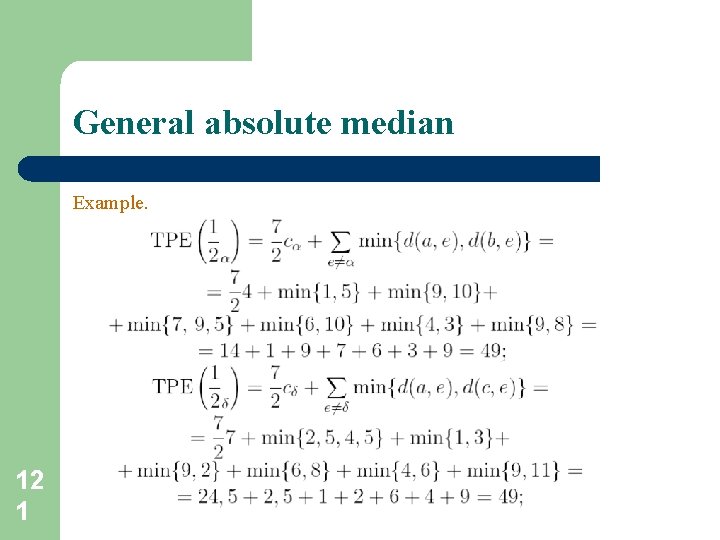
General absolute median Example. 12 1
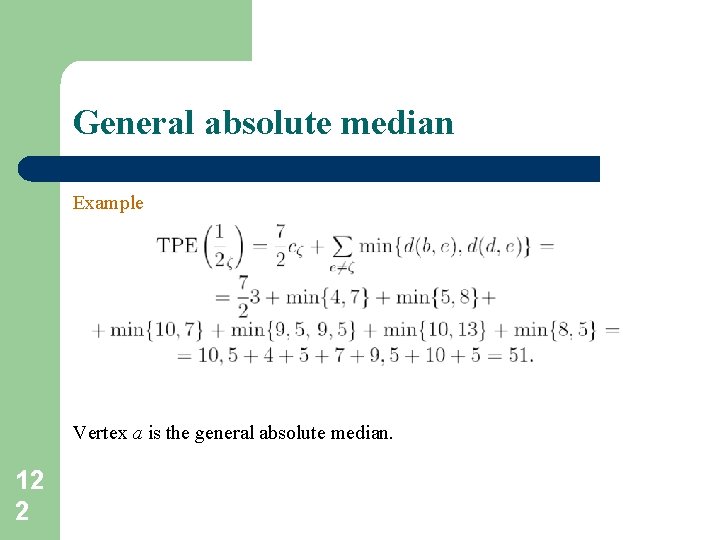
General absolute median Example Vertex a is the general absolute median. 12 2
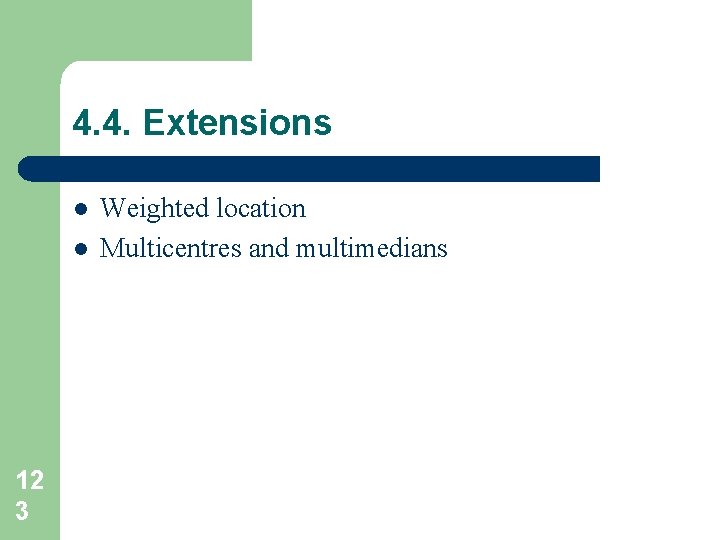
4. 4. Extensions l l 12 3 Weighted location Multicentres and multimedians
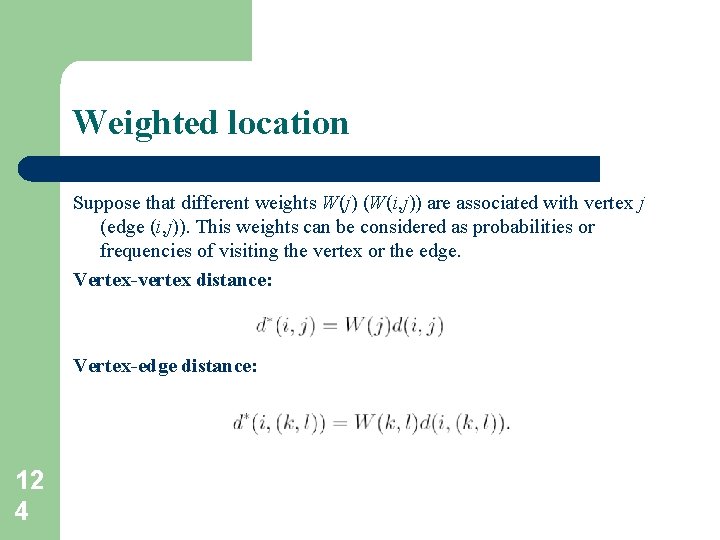
Weighted location Suppose that different weights W(j) (W(i, j)) are associated with vertex j (edge (i, j)). This weights can be considered as probabilities or frequencies of visiting the vertex or the edge. Vertex-vertex distance: Vertex-edge distance: 12 4
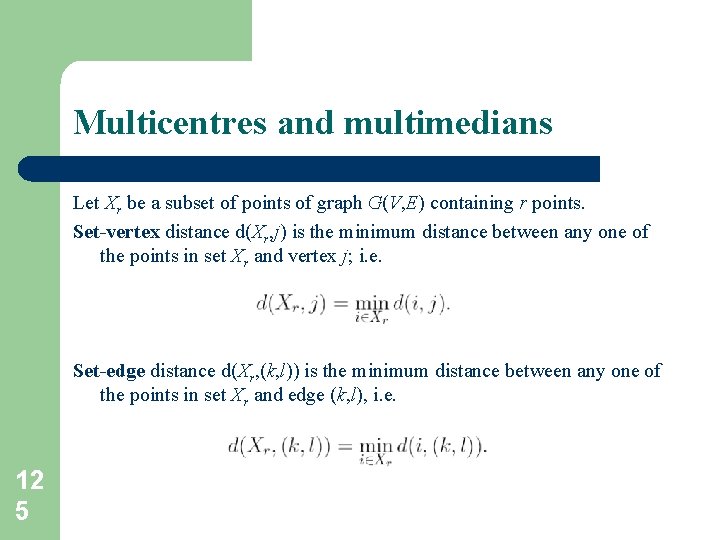
Multicentres and multimedians Let Xr be a subset of points of graph G(V, E) containing r points. Set-vertex distance d(Xr, j) is the minimum distance between any one of the points in set Xr and vertex j; i. e. Set-edge distance d(Xr, (k, l)) is the minimum distance between any one of the points in set Xr and edge (k, l), i. e. 12 5
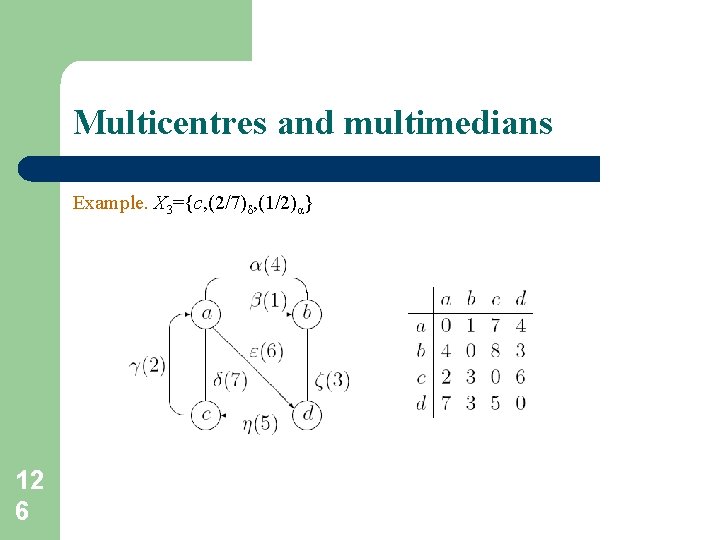
Multicentres and multimedians Example. X 3={c, (2/7)δ, (1/2)α} 12 6
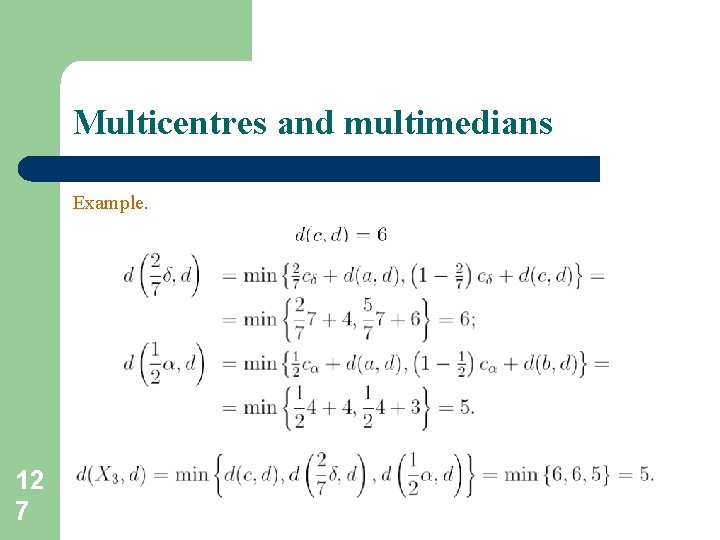
Multicentres and multimedians Example. 12 7
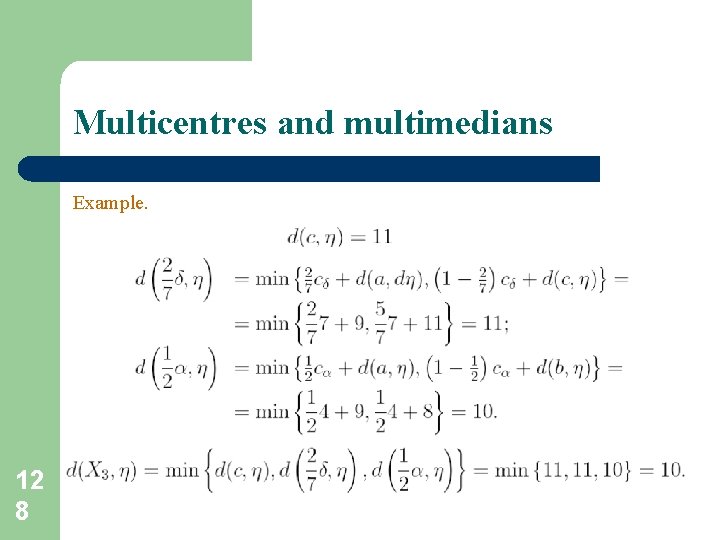
Multicentres and multimedians Example. 12 8

Multicentres and multimedians Multicenter and multimedian problems arise when there is a need to locate a number of facilities in the best possible way. The following distances can be minimize: l Maximum set-vertex distance (MSV) l Maximum set-edge distance (MSE) l Total set-vertex distance (TSV) l Total set-edge distance (TSE) 12 9
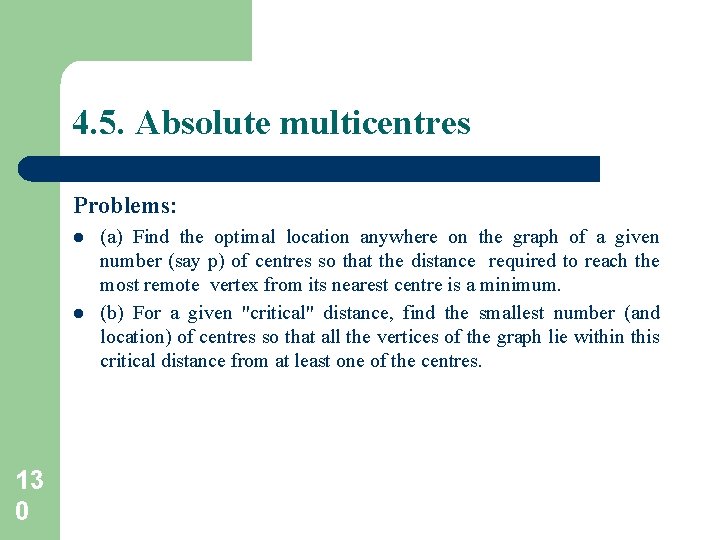
4. 5. Absolute multicentres Problems: l l 13 0 (a) Find the optimal location anywhere on the graph of a given number (say p) of centres so that the distance required to reach the most remote vertex from its nearest centre is a minimum. (b) For a given "critical" distance, find the smallest number (and location) of centres so that all the vertices of the graph lie within this critical distance from at least one of the centres.
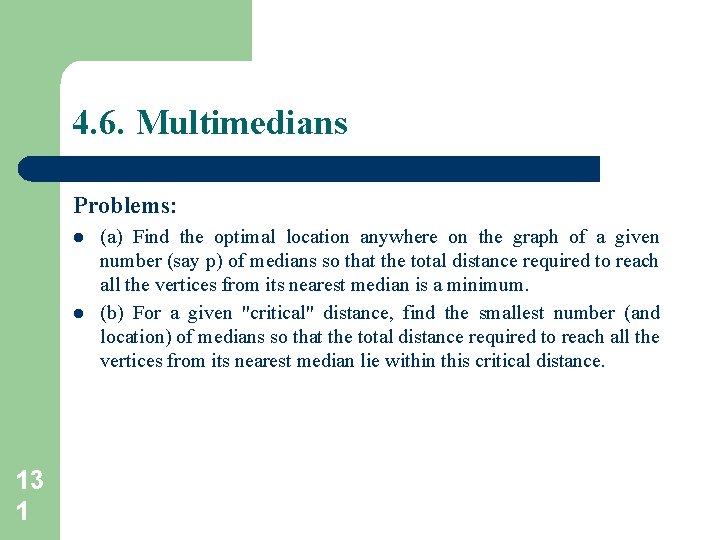
4. 6. Multimedians Problems: l l 13 1 (a) Find the optimal location anywhere on the graph of a given number (say p) of medians so that the total distance required to reach all the vertices from its nearest median is a minimum. (b) For a given "critical" distance, find the smallest number (and location) of medians so that the total distance required to reach all the vertices from its nearest median lie within this critical distance.
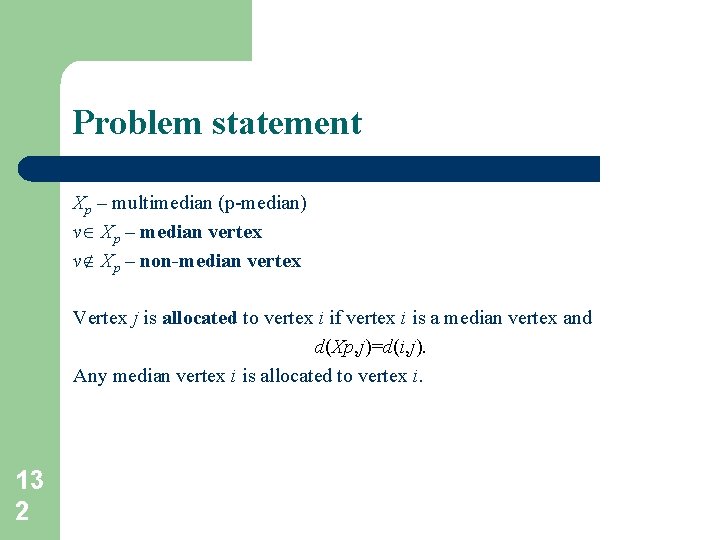
Problem statement Xp – multimedian (p-median) v Xp – median vertex v Xp – non-median vertex Vertex j is allocated to vertex i if vertex i is a median vertex and d(Xp, j)=d(i, j). Any median vertex i is allocated to vertex i. 13 2
- Slides: 132